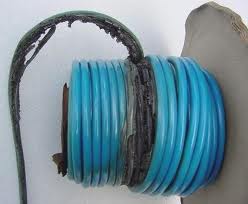It's all about the cooling
All the failures you see above are the wires overheating. You have many wires in close proximity, all getting warm. This dense "clump" of wires simply cannot dissipate the heat, and they have a "meltdown".
The National Electrical Code talks about this, in the various parts of NEC 310.15. Here is the "Cables bunched together" (coiled=raceway) derate table.

You see these burned up coils with 20+ loops of cable... that's 40+ conductors bundled on the reel, which calls for derating cable capacity to 35%. Now, many cables can't run at 90C, so you have to derate from the temperature they are good for. Say your 16 AWG extension cord is good for 60 degrees C, NEC 310.15(B)16 doesn't have a figure for that, but we can extrapolate and get 11A. Derate that to 35%, and we have 3.85 amps. That's all you should be putting through it when it's coiled up on the reel like that!
Of course, people are pulling 10-12 amps, that's why it burnt up.
But if you're pulling 1-2 amps through that coiled up cord, that's no problem as you can see.
Are those derates a burden for house wiring? No. Small house wiring derates off the high 90C number, but is statutorially required to use the 60C number (NEC 240.4) which is below 70% anyway, so the 70% derate doesn't really hurt. That lets you have 9 active conductors or 4 circuits in a cableway. 4 circuits because in 120/240V split-phase power, heat from 3 conductors (hot-neutral-hot) will never exceed the heat output of 2 conductors, so counts as two.





